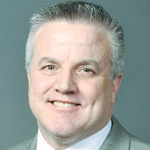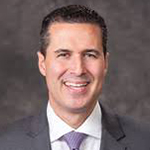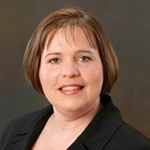By LISA EISENHAUER
May 7, 2020
As of Wednesday, hospitals that provided testing and treatment of uninsured COVID-19 patients could begin requesting reimbursement of their costs from the federal government.

Chandler
The reimbursement is among a number of potential ways that health care providers can tap federal funding that has been allocated in recent weeks to help cover the costs of taking care of people who have contracted or thought they might have contracted the deadly virus during the current pandemic or other costs related to the national emergency.
The myriad programs available were detailed during a webinar on May 1 hosted by CHA and moderated by Loren Chandler, CHA's chief operating and finance officer. More than 260 people registered for the webinar, including senior executives in finance, operations and risk management at Catholic hospitals and health systems.
Each of the federal assistance programs discussed during the broadcast has specific application and accounting rules. Many of those rules were explained by representatives of Hagerty Consulting, which specializes in emergency management, and executives who oversee financial operations at Bon Secours Mercy Health, a 43-hospital system based in Cincinnati.

Bokser
For example, to apply for the reimbursement funding for providing care to uninsured patients, which is being funneled through the U.S. Department of Health and Human Services, hospitals have to register at a special portal set up by the department. The claims can be submitted starting today for COVID-19 treatment and testing as far back as Feb. 4.
Jeff Bokser, senior health care executive with Hagerty Consulting, said the reimbursement funds are a limited "first come, first served allocation."
Aid crosses various agencies
Bokser pointed out that the Centers for Medicare and Medicaid Services is administering several pandemic-assistance programs. One is the rollback of the plan to sequester 2% of all Medicare fee-for-service payments. "This applies automatically, so nothing needs to be done other than submit your claims the way you normally would," Bokser said.
CMS is also automatically adding on 20% to the Medicare reimbursement rate for all services to patients with COVID-19, Bokser said.
The funding for the assistance that HHS and CMS is overseeing was provided in the various pieces of legislation that have been passed since the start of the health crisis, including $100 billion in the Coronavirus Aid, Relief, and Economic Security (CARES) Act and $75 billion in the Paycheck Protection Program and Health Care Enhancement Act.
Aside from assistance that is specific to health care providers, Bokser said that hospitals can apply for other federal aid that is being made available to businesses and organizations in response to the pandemic. That other aid includes postponement of payment of the 6.2% federal payroll tax known as FICA and loans from the Small Business Administration or the Main Street Lending Program.
In addition, some funding available specifically to health care providers is being administered by agencies not traditionally associated with health care, Bokser said. The Federal Communications Commission, for example, has more than $200 million available for the COVID-19 Telehealth Program. Applicants can request up to $1 million. And the Department of Education has $14 billion to parcel out to hospitals that offer graduate medical education or train medical students.
Accounting considerations
Deborah Bloomfield, chief financial officer of Bon Secours Mercy, said that system is following grant revenue accounting rules for any federal funding it gets for pandemic-related expenses. "That would mean that, as COVID-19 expenses are being incurred, we would recognize the revenue and match (their recording) that over the same time period," she said.

Bloomfield
Bloomfield also noted that some funding might have to be returned. "Keep in mind that there are some clawback potentials with this that you should address as well as to whether a reserve should be applied," she said.
Bloomfield offered to share with other systems the accounting policy that Bon Secours Mercy is following for its pandemic expenses and the accounting tools, such as templates, that it is using to track them.
Billie Jean Mounts, Bon Secours Mercy's chief revenue officer, pointed out that questions remain about the specifics of some of the programs and providers might have to be their own advocates for assistance. For example, she said, it is unclear if Medicare Advantage plans are going to honor the change in the sequester plan and the 20% add-on for COVID-19 care.

Mounts
"We have seen in reconciling payments that not all of them have put this in place yet, and so just something to be aware of that, that you may have to be asking your commercial payers to put these rules in place," Mounts said.
FEMA resources
Another potentially large source of assistance to care providers is the Public Assistance Program run by the Federal Emergency Management Agency. Mark O'Mara, director of recovery for Hagerty Consulting, said this program provides funding to state and local governments as well as private nonprofit organizations after a major disaster or emergency declaration. Among the disasters it has helped cover costs for in the past are Hurricane Katrina and the 9/11 attacks.

O'Mara
"Historically hospitals underutilize the FEMA Public Assistance Program for a variety of reasons," O'Mara said. "The reality is that this is a major funding opportunity and, unlike all of the previously presented funding opportunities and programs, there is no cap to this. It is not competitive. It is not first come, first serve."
He said that for qualifying expenses, the FEMA program picks up 75%. The rest of the cost is covered by either states or the care providers.
Because of the scope of the COVID-19 pandemic, O'Mara said FEMA is streamlining the application process but also offering less support in that process. "As part of that, they're pushing more of the responsibility for the development, the request, the management and the eventual closeout of these processes to you," he said. In effect, he added, hospitals that get the funding will have more leeway in setting their priorities and timelines.
The first rule of thumb in applying for FEMA funding, O'Mara said, is to ask: "Is this cost as a direct result of COVID-19 and does it lessen or eliminate threat to public health and safety?" The funding, he said, could potentially cover a long list of expenses, including those for medical treatment, prescriptions, personal protective equipment, durable medical equipment, medical waste and transport, and temporary facilities and expansions.
All those expenses as well as any others that health systems and hospitals get federal assistance with need to be clearly accounted for, both the Hagerty Consulting and Bon Secours Mercy representatives said. "The federal Office of Inspector General, or OIG, is being funded through the exact same legislation as the different recipients of this money are," O'Mara said. "Their sole metric for success is how much money they're able to call back."
» Federal pandemic relief funding available to hospitals
View the webinar recording